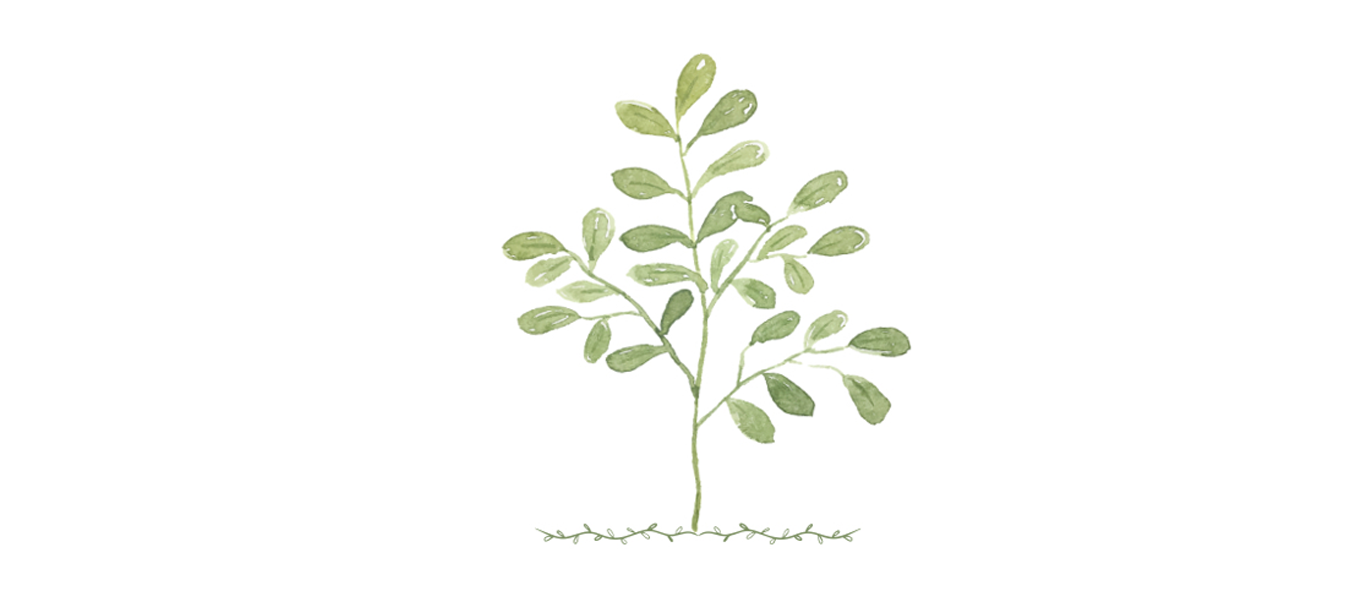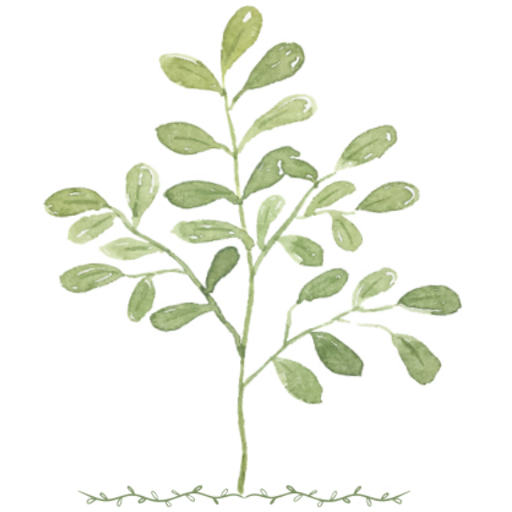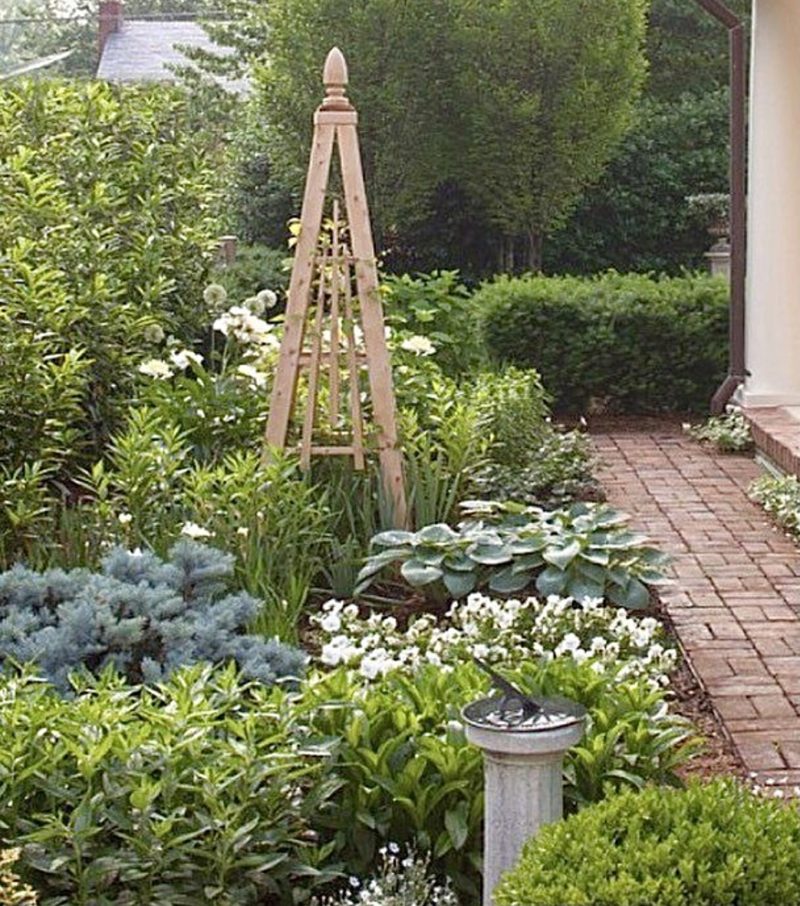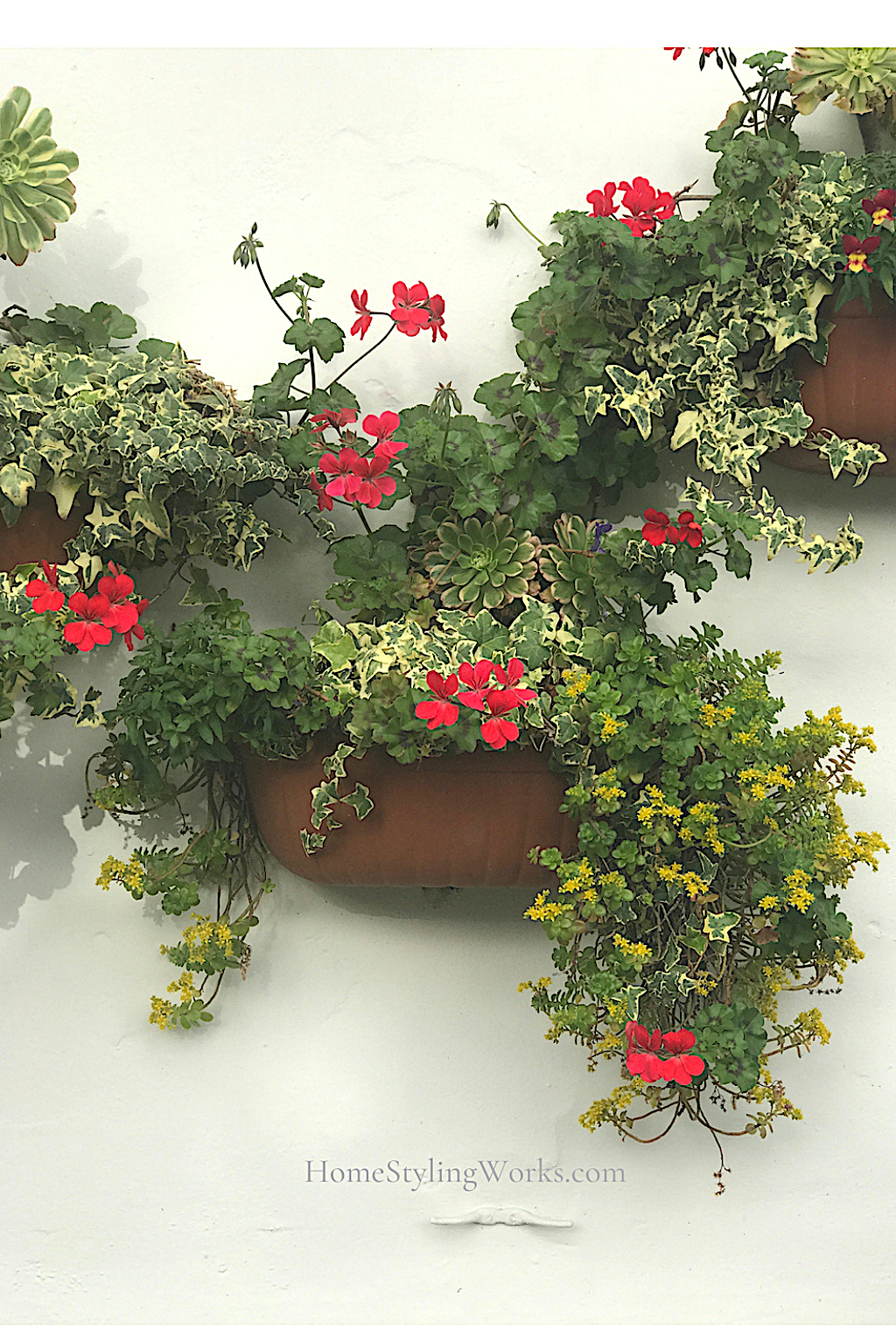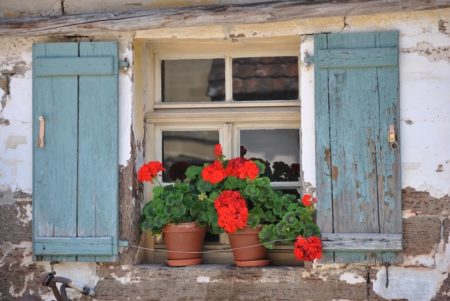ADDING HEIGHT & DRAMA WITH TALL TUTEURS IN CONTAINERS
In the 30 years I’ve been gardening, I’ve always found a way to incorporate vertical elements into my garden designs. Oftentimes, verticality in the garden can be accomplished with trees. But you can also add height to your garden with structural elements, as well. That’s where tuteurs and obelisks come in. In my previous post, I’ve shown how these interesting structures can be planted directly in the ground (with or without climbing plants), as I did in my garden in Saratoga Springs, New York. But since I love container gardening, I thought it would be interesting to design a couple of tuteur-and-planter combinations that can be used in a variety of settings.
SCALE & PROPORTION
Before we get to the drawings with tuteur-planter combos, let’s talk about SCALE and PROPORTION. The key to making a beautiful tuteur-planter combination is to make sure the proportions are correct. That means the size of the planter and the height of the tuteur complement each other. You don’t want the planter to be huge and the tuteur tiny (or vice-versa – you don’t want the tuteur looking like it’s going to topple over with the slightest bit of wind!)
And speaking of wind – there’s a reason why tuteurs are either planted in the ground or in a container. You don’t want them blowing into your neighbor’s yard (or, worse yet – having a porch pirate make off with your pretty tuteurs! They’re much less of a target when they’re planted in a large container with climbing plants).
A SIMPLE FORMULA
To make sure that the tuteur and planter are in proportion to one another, I’ve created a simple formula:
The HEIGHT of the tuteur should be 2.5 to 3 times taller than the height of the planter. A 2.5-3.5 to 1 ratio.
I’ve done a quick sketch below that shows containers and tuteurs that are incorrectly proportioned. Too large of a container with too small of a tuteur looks inconsequential. And too large of a tuteur in too small of a container looks like a toppling hazard.
DON’T DO THIS (see image below):

THE RIGHT TUTEUR + THE RIGHT PLANTER
In the drawings below, I’ve selected two tuteurs and two planters – one a medium size and another a larger size. I created these drawings as a visual guide, with measurements, so you can see the scale and proportion concept in action. I’ve sketched the concept to show you how to scale my curated selection of tuteurs and obelisks with the properly scaled containers.
STYLE #1: TUTEUR + PLANTER COMBINATION
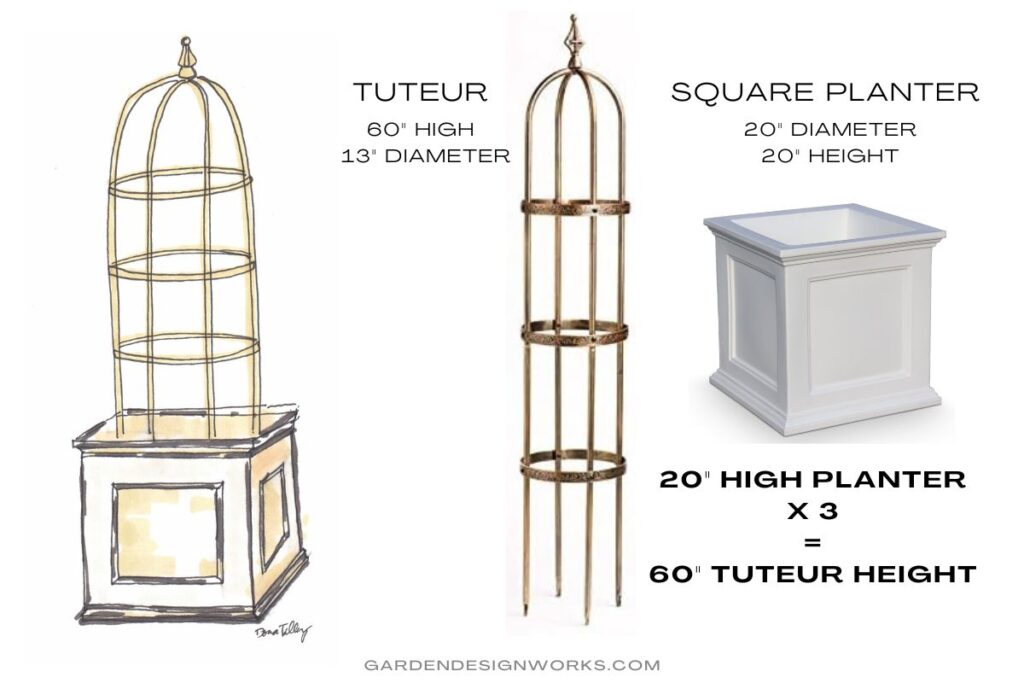
In the drawing above, the square planter is 20″ high x 20″ in diameter (it comes in white, gray, black and dark brown). Multiplied by 3 = 60″ high. This beautiful tuteur in an antique copper finish by Plow & Hearth is 60″ high. BINGO! If you factor in burying the stakes in the soil a few inches, that makes the height of the tuteur about 55″ high. Perfect. Now, you can go a little taller, but I wouldn’t recommend any higher than a 3.5:1 ratio. That means the tuteur shouldn’t be any higher than 66″ overall. Scale and proportion are key to making this look right.
STYLE #2: A GRAND STATEMENT
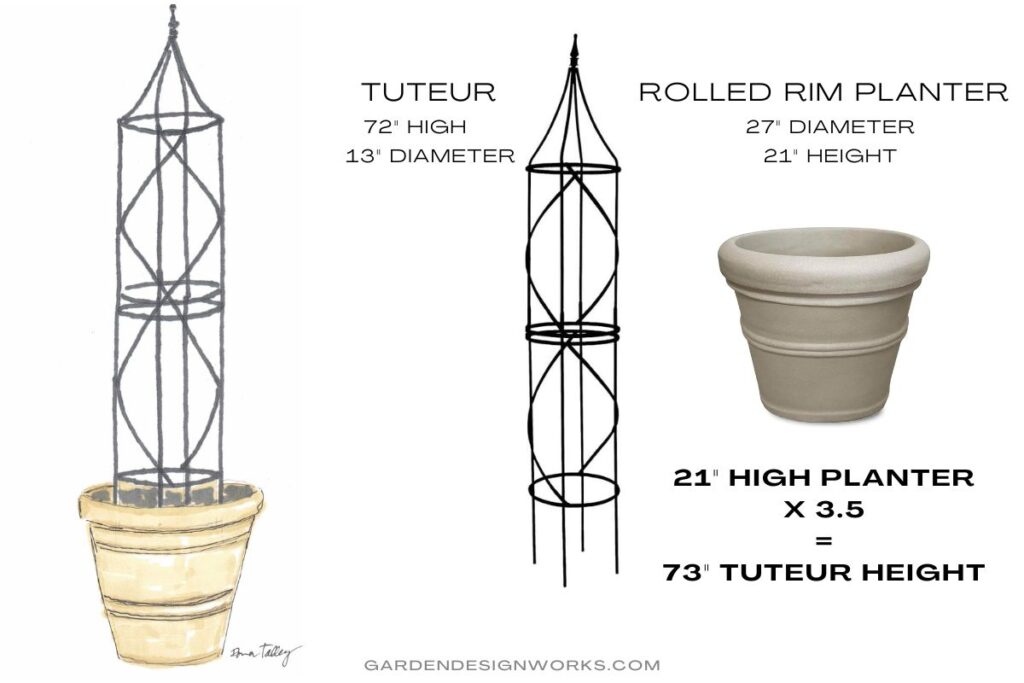
For the second drawing shown above, I chose a classic rolled rim Brunello planter that is 21″ high x 27″ in diameter. The tuteur I chose is very high quality from a favorite garden source, The Kinsman Company. The gorgeously shaped tuteur in black is 72″ high and 13″ in diameter, which fits the 3.5:1 ratio outlined above. The diameter of the planter and tuteur is also important because you want to make sure the tuteur fits comfortably into the top of the planter. A little room around the tuteur inside the planter allows you to add plants.
This tuteur/planter combination would make a lovely focal point in the center of a garden.
PLANTS THAT LOVE TO CLIMB
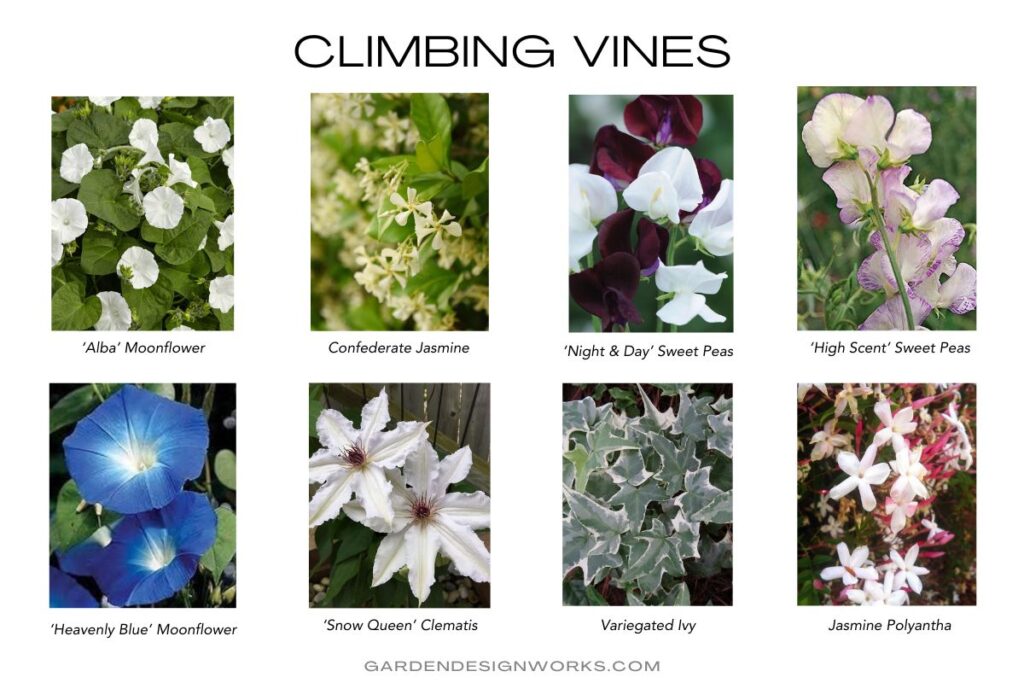
The next part is fun! You get to design some beautiful container gardens, with the tuteur as the “superstar”.
But first, keep in mind that not all climbing vines are suitable for tuteurs (especially in containers). For example, climbing hydrangea and wisteria vines are heavy and need much more support than a tuteur can offer. Check with your local nursery for plants designated for your particular zones. To get you started, here are a few of my favorite climbing vines for tuteurs:
FULL SUN PLANTS:
Fragrant Jasmine Vines: The white Confederate Jasmine or the pink Jasmine Polyantha have an intoxicating fragrance that would be wonderful next to an entry.
White Moonflower: An easy-to-grow annual, white moonflower has the added bonus of blooming at night. This would be beautiful planted as the centerpiece of a garden you enjoy in the evening. It also looks great surrounded by sun-loving silver foliage plants such as Dusty Miller or Lamb’s Ears.
Blue Moonflower: The blue counterpart to the white moonflower, this is super easy to grow and the color is a real showstopper.
Sweet Peas: A very fragrant plant that comes in a beautiful rainbow of colors – sweet peas are the epitome of cottage garden plants. ‘High Scent’ sweet peas in a soft pink shade would be nice near a window or entry. I’m also a fan of dark-colored flowering plants, and these ‘Night and Day’ burgundy and white sweet peas would look lovely climbing on the copper tuteur.
PART SHADE PLANTS:
Flowering Clematis is a perennial, so you cut the vines back to about 6″ after the last frost, and they come back every year. Clematis comes in a variety of colors — from deep pink to tie-dye purple, and of course, white. I love the “Snow Queen” variety climbing on a gunmetal gray obelisk. Keep in mind that clematis like their roots in the shade and the flowers in the sun.
SHADE PLANTS:
English Ivy (‘hedera helix”): Very “English garden” looking and classic. Outdoors, this plant thrives in shade. Rex Begonias, with their gorgeous foliage, would be a nice companion plant around the perimeter of the container.
SHOP MY FAVORITE TUTEURS & OBELISKS
Here are a few of my favorite, high-quality tuteurs and obelisks. The product links are below the image, with corresponding numbers. Happy shopping!
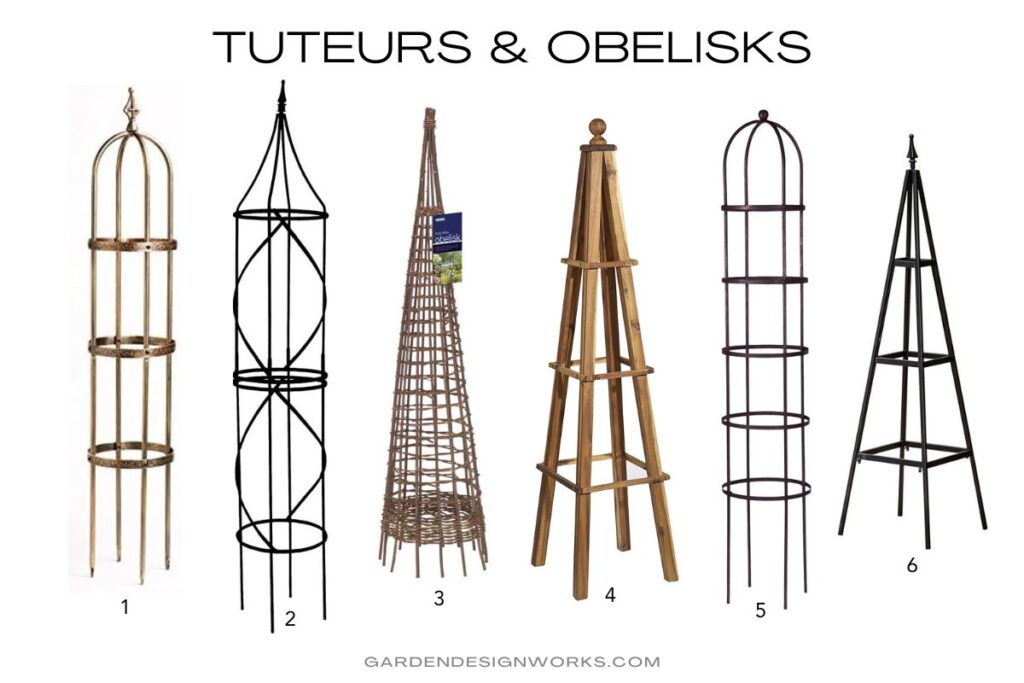
- Plow & Hearth obelisk in an antique copper finish
- Medium border tuteur by Kinsman Company
- Gardman 4.9′ Willow obelisk
- Classic Home & Garden 3-rung acacia wood obelisk, 60″
- Gardener’s Supply Essex Round Trellis, 72″
- Spring Hill Nurseries French Country Folding Tuteur
ADDITIONAL S SUPPLIES
I recommend using either plant velcro tape or green garden clips to attach the vines to the tuteur.
TUTEUR + PLANTER ‘IN SITU’
I’m finishing up the post with an image I sketched that shows a pair of tuteurs in planters flanking a front door. As you can see, this would be an elegant and timeless focal point for a traditional entry.
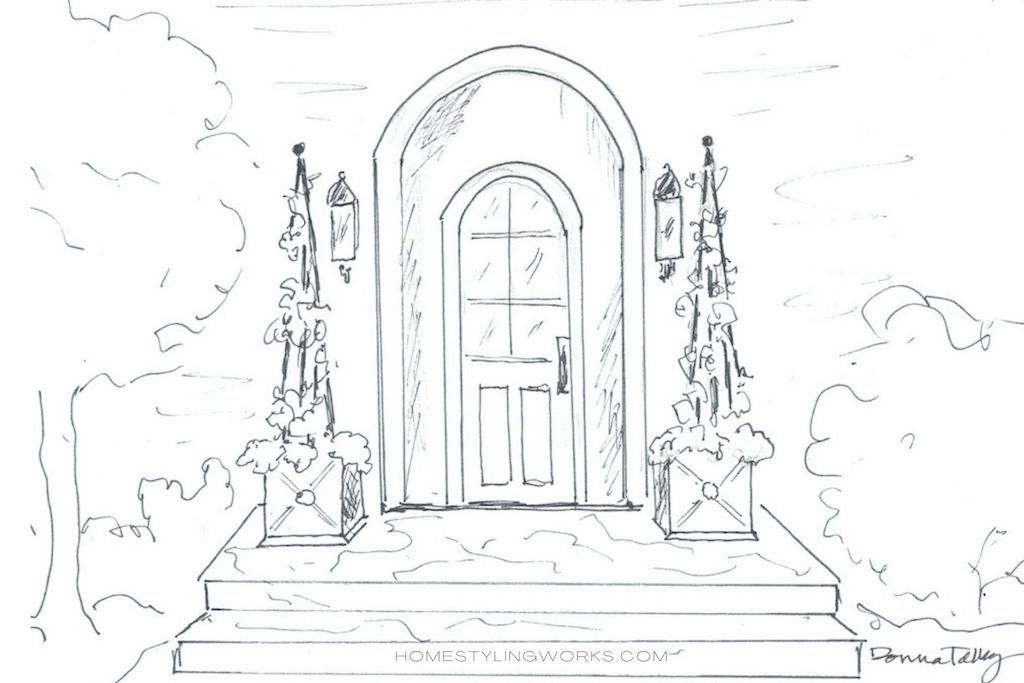
Thanks so much for stopping by, and I hope this post has inspired you to incorporate tuteurs and planters in your garden to Make Your Every Day More Beautiful®.
